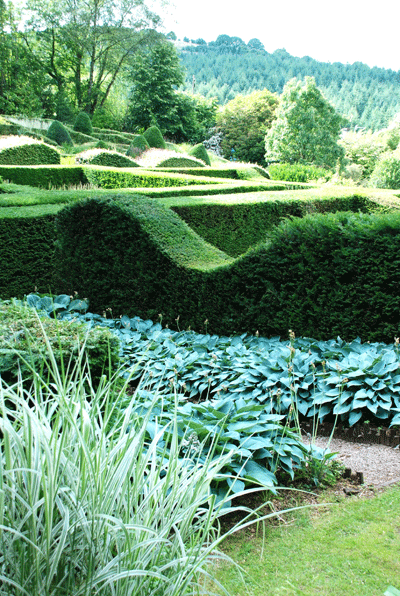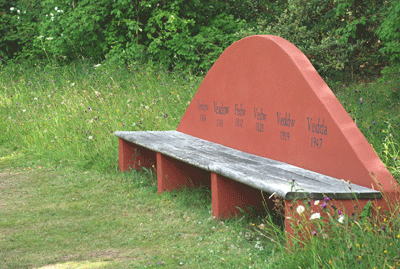A new garden in an old place
Françoise explores a fascinating private garden which combines historical elements with a contemporary sensibility

How do you design and build a garden that embraces new ideas, new concepts yet still manages to retain its history? How does a garden keep a sense of place in the 21st century?
It's a difficult task but something that Anne Wareham and her husband Charles Hawes of Veddw House have managed to do with aplomb. A mix of ingenuity, sheer hard work, determination and a tight budget, Anne's garden is the perfect example of an old site re-interpreted, re-worked and updated to bring it into the 21st Century.

View of Veddw garden
Veddw, pronounced vedoo, is a private garden and an on-going life's work for Anne. When I visited, her enthusiasm and curiosity about the world was palpable. Anne is fascinated with the history of the site and she wanted to design and build a thoroughly modern garden which was still influenced by its past.
Her research has taken many painstaking months of work, something not to be underestimated by any owner of a period garden or landscape. From historical societies to ancient maps it is not just a matter of gathering the information but also interpreting the information and understanding the society of the time.
The 200 year old cottage on the Welsh border near Tintern in the village of Devauden, Monmouthshire, was originally built by a squatter who also took over the land that surrounds the property. Before the 18th and 19th century there was little planning to settlements, and their haphazard nature was in part due to the migrant nature of the populace searching for work wherever it was available.
Anne's research of her garden and house bears witness to this high degree of mobility, but she has also unearthed some interesting discoveries: notwithstanding that people did move around a lot, they did not necessarily hand down their house and land to their families as these were mostly leased properties as described in the Tithe Map of 1842. She also discovered that Veddw was once owned by a woman who had a long lease on it with three named "lives" - three people one could name to inherit the lease. Not the ordinary picture of the women in the 18th and 19th century that we usually read about!
Exquisite houses, the beauty of Nature, and how to get the most from your life, straight to your inbox.
Listening to Anne I was fascinated by the etymology of names, the way they change over the years and decades- a bit like the fashion trends of today! Vedow, Veadow, Fedw, Vedw, the list goes on.
As owners of period properties and gardens may already know, history is not static. Things change, new facts are uncovered, old stones unearthed revealing more details about the previous inhabitants and their lives. All this contributes to shaping a new future.
The Veddw is a modern four acre garden that does away with the usual pastiche that one often sees in renovated or restored historical gardens or landscapes. No prissy planting or shapes here, no old statuary or customary parterres. The garden is not based on an old garden, style or period. Bold, architectural, it sits firmly in the natural amphitheatre which frames its north facing slope and continues around the house to its south facing Potager and meadow.
You can see that the history of the land fascinates Anne and there is a reference to the Tithe Map of 1841 in the very modern parterre of box which forms a cutting pattern on one slope of the garden. These are not only ornamental but serve to visually balance out the uneven ground and differing heights of the garden. The ornamental grasses are planted block-like, contained within a loose geometry.

The bench
Standing at the top of the slope near a bench marked with the different names of the The Veddw mentioned earlier, I was struck by the sense of place and history of this garden. It felt very exciting to see the developments of its history on a variety of markers within the garden but also the new, fun and sometimes very unusual planting combinations that I found there.
The wave-like hedges that are opposite the parterre enclose a variety of smaller garden rooms. The yew hedging is bold, high and sometimes over-bearing by its darkness and density. Although one feels an old fashioned sense of enclosure in a formal hedge design, the details within it are strikingly modern.
Take the small garden that I discovered. I could hear water sloshing about from behind a hedge. A room divided into 6 plots - very formal indeed, very ‘normal' but when I walked in it was a real ‘wow' moment!

The Cornfield garden
The narrow entry flanked by tall hedges does not prepare you for what you discover, and that's where Anne succeeds in giving the visitor a complete sense of surprise. The wild effect of the grasses constrained within low hedges and railings was stunning. I can see where Anne often plays off ‘natural' with ‘wild', blurring the divide.
The planting for me was reminiscent of Fernando Caruncho's agricultural landscapes, designed to integrate the rural agrarian elements within a design. The water feature lightened the very enclosed space with its tingling sounds.
The garden is full of surprises not only in its design and bold planting but in its reference to the ancient landscape and woods beyond. At every turn there is something to absorb, and to ask Anne about. The tomb-like markers within the wild meadow, the dark still pool that makes you want to dive in and discover the underworld, the Potager with its architectural cardoons contained again within formal box hedges, the blue benches, the huge boulders in the woodland, the ruin of another cottage on the upper north west slope. The list is endless.

The enclosed garden and reflecting pool
I came away inspired, invigorated and amazed. Anne and her husband Charles have shown me in a very vivid manner the way one can pull together a historic old landscape or garden and take elements from the past and integrate them into the here and now without falling into the one ‘style' or one ‘period' look. To dust the old path behind you and yet still manage to build a path that leads you to the future is a very difficult endeavour - it's not just about research, faithful restoration or recreation but about interpretation of the information, courage to undertake such a momentous project and determination to do what you want in a manner that gives you satisfaction and pleasure.
Francoise Murat & Associates www.francoisemurat.com is a Garden, Landscape and Architectural interior design practice. The practice runs a series of http://www.francoisemurat.com/workshops/ practical one day workshops and courses at their offices in Hampshire in September, October and November, including "Restoring period gardens" an introduction for anyone who owns a period garden on how restore and re-design their garden.
Francoise Murat & Associates is a member of ProjectBook which has been created to help owners of listed or period properties understand how their buildings work and to help them find appropriate craftsmen, products and specialist information. The online Heritage Register contains over 540 registered businesses, the largest directory of its type in the UK. For more information, visit www.projectbook.co.uk

* Follow Projectbook on Twitter
Country Life is unlike any other magazine: the only glossy weekly on the newsstand and the only magazine that has been guest-edited by His Majesty The King not once, but twice. It is a celebration of modern rural life and all its diverse joys and pleasures — that was first published in Queen Victoria's Diamond Jubilee year. Our eclectic mixture of witty and informative content — from the most up-to-date property news and commentary and a coveted glimpse inside some of the UK's best houses and gardens, to gardening, the arts and interior design, written by experts in their field — still cannot be found in print or online, anywhere else.
